- 2013-04-06
Jared Males
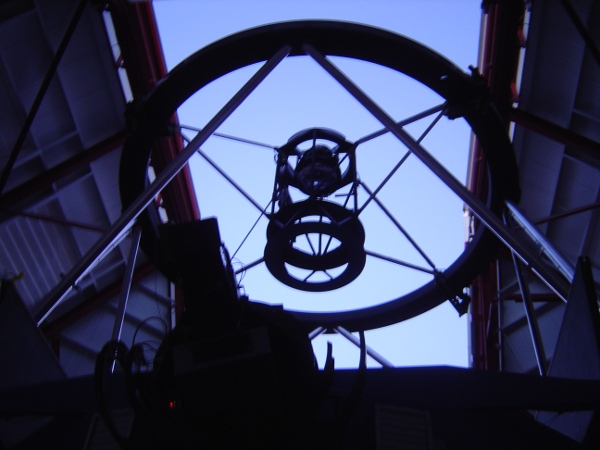
Tonight both Clay and Baade belonged to astronomers from Steward Observatory. Bear down.
Over on the diffraction limited side, we had a great night. We observed some young low-mass companions to stars (later we can argue about labels like “brown dwarf” and “planet” – all I know for sure is that they were all ...
- 2013-04-05
Vanessa Bailey
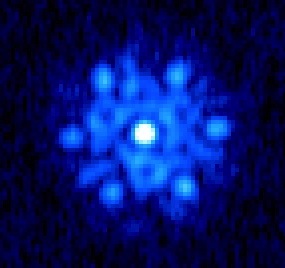
Today we saw snowflakes here at Magellan! Thankfully, the weather was beautiful without a cloud in the sky; the snowflakes were on Clio.
This is an image of a star. Although it looks distorted, this image is actually great. If our AO system is performing well, the image shape (the technical term is “point spread function”) ...
- 2013-04-04
TJ Rodigas

This is my second post ever. I guess that makes me no longer a rookie…
Tonight went pretty smoothly. Most of the night was spent doing science observations of faint companions. Because we have two science cameras, we were able to obtain some pretty cool images on both cameras–simultaneously!
The AO continued to perform very well, aside ...
- 2013-04-03
Jared Males
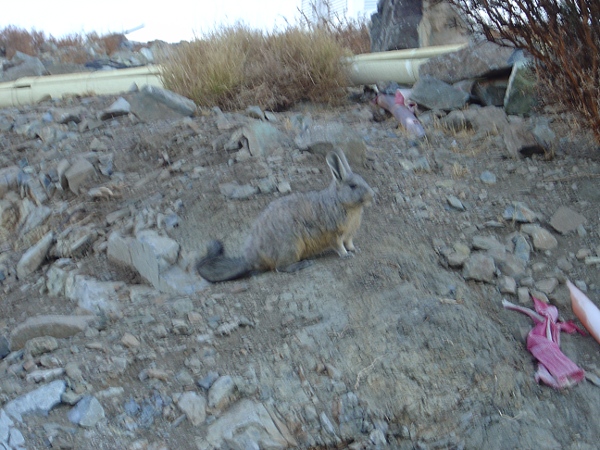
Tonight I saved over 73000 images on one target. That wore me out.
We had a good night – seeing was fairly good all night and we did some good engineering work in the first half. Clio’s prism spectrograph was aligned and focused, and we did some more photometric standard measurements with VisAO. ...
- 2013-04-02
Kate Follette
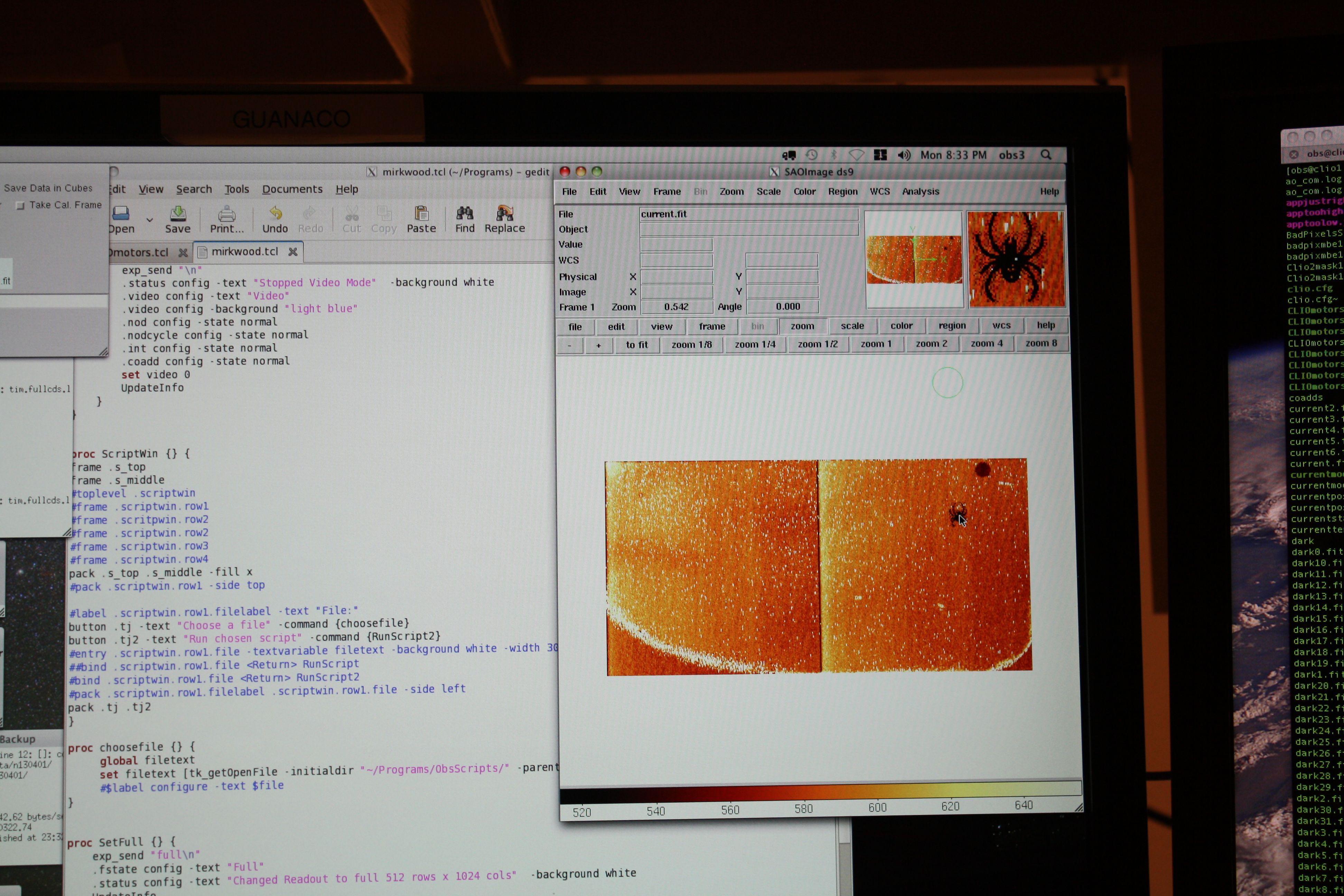
We started off the night trying to track down the mysterious source of a perfectly symmetrical spider (literally a spider!) that kept popping up in the Clio viewer (see Jared’s post from earlier today for more details). Luckily, Povilas was working on the pointing model at the time, so we were able to indulge in ...
- 2013-04-01
Jared Males

Just before starting our science observations tonight, we discovered a major bug in the Clio software.
Well played, Professor Hinz. Well played.
“That looks like a spider.” — TJ
“You can see the bad pixels through the spider.” — Laird
“This is the most in-focus image I’ve seen on Clio.” — Alfio
Postedit:
The fun continued… the culprits are ...
- 2013-04-01
Katie Morzinski
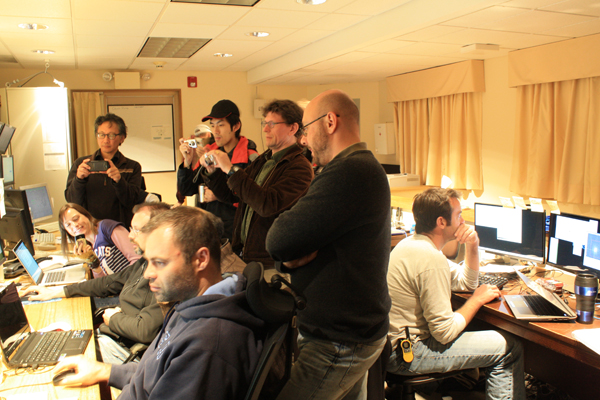
On November 26th, 2012, we closed the loop for the first time on-sky here at Magellan. A multitude of cameras and video recorders were there to document the moment. Here we present a three-dimensional tomographic reconstruction of the first-light Magellan adaptive optics controllers.
We input these images into our FPGA reconstructor, to obtain the ...
- 2013-04-01
Katie Morzinski
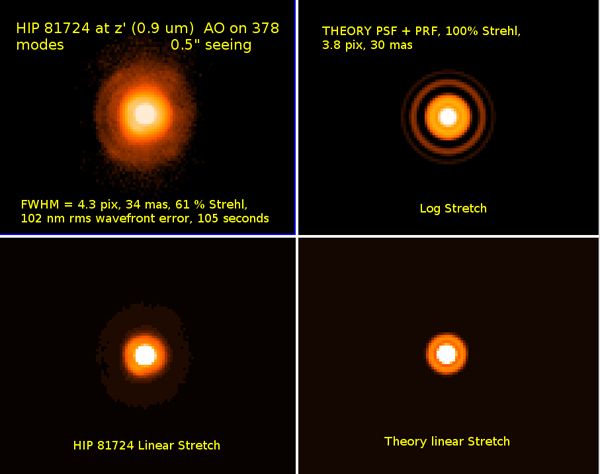
Tonight was our second night on-sky this run, and we have been accomplishing many engineering tasks. With the AO system, we have been testing and optimizing our AO parameters. Here is a PSF from yesterday, with only ~100 nm phase rms WFE:
With VisAO, we are calibrating our photometric system. With Clio, we ...
- 2013-04-01
Jared Males
Under certain conditions, such as high winds or observing faint stars, it is advantageous to use the shortest exposure times (~20 msec) of the VisAO camera and perform Lucky imaging. This technique is based on first selecting only the best images in a sequence of short exposures, and then shifting-and-adding (SAA) the results. ...
- 2013-03-31
Katie Morzinski
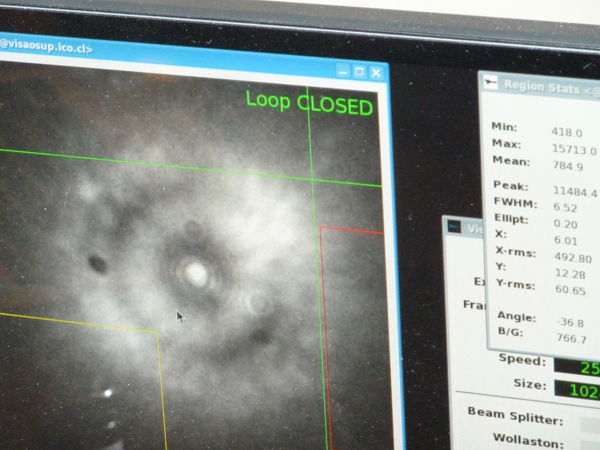
Tonight we closed the loop on-sky, on Kate and T.J.’s first night here this run.
We were able to use the new pupils we calibrated over the last few days, and Marco’s new interaction matrix, to close the AO loop with 378 modes. This was a big step forward! The wavefront error was close to ...
 Tonight both Clay and Baade belonged to astronomers from Steward Observatory. Bear down. Over on the diffraction limited side, we had a great night. We observed some young low-mass companions to stars (later we can argue about labels like “brown dwarf” and “planet” – all I know for sure is that they were all ...
Tonight both Clay and Baade belonged to astronomers from Steward Observatory. Bear down. Over on the diffraction limited side, we had a great night. We observed some young low-mass companions to stars (later we can argue about labels like “brown dwarf” and “planet” – all I know for sure is that they were all ... Today we saw snowflakes here at Magellan! Thankfully, the weather was beautiful without a cloud in the sky; the snowflakes were on Clio. This is an image of a star. Although it looks distorted, this image is actually great. If our AO system is performing well, the image shape (the technical term is “point spread function”) ...
Today we saw snowflakes here at Magellan! Thankfully, the weather was beautiful without a cloud in the sky; the snowflakes were on Clio. This is an image of a star. Although it looks distorted, this image is actually great. If our AO system is performing well, the image shape (the technical term is “point spread function”) ... This is my second post ever. I guess that makes me no longer a rookie… Tonight went pretty smoothly. Most of the night was spent doing science observations of faint companions. Because we have two science cameras, we were able to obtain some pretty cool images on both cameras–simultaneously! The AO continued to perform very well, aside ...
This is my second post ever. I guess that makes me no longer a rookie… Tonight went pretty smoothly. Most of the night was spent doing science observations of faint companions. Because we have two science cameras, we were able to obtain some pretty cool images on both cameras–simultaneously! The AO continued to perform very well, aside ... Tonight I saved over 73000 images on one target. That wore me out. We had a good night – seeing was fairly good all night and we did some good engineering work in the first half. Clio’s prism spectrograph was aligned and focused, and we did some more photometric standard measurements with VisAO. ...
Tonight I saved over 73000 images on one target. That wore me out. We had a good night – seeing was fairly good all night and we did some good engineering work in the first half. Clio’s prism spectrograph was aligned and focused, and we did some more photometric standard measurements with VisAO. ... We started off the night trying to track down the mysterious source of a perfectly symmetrical spider (literally a spider!) that kept popping up in the Clio viewer (see Jared’s post from earlier today for more details). Luckily, Povilas was working on the pointing model at the time, so we were able to indulge in ...
We started off the night trying to track down the mysterious source of a perfectly symmetrical spider (literally a spider!) that kept popping up in the Clio viewer (see Jared’s post from earlier today for more details). Luckily, Povilas was working on the pointing model at the time, so we were able to indulge in ... Just before starting our science observations tonight, we discovered a major bug in the Clio software. Well played, Professor Hinz. Well played. “That looks like a spider.” — TJ “You can see the bad pixels through the spider.” — Laird “This is the most in-focus image I’ve seen on Clio.” — Alfio Postedit: The fun continued… the culprits are ...
Just before starting our science observations tonight, we discovered a major bug in the Clio software. Well played, Professor Hinz. Well played. “That looks like a spider.” — TJ “You can see the bad pixels through the spider.” — Laird “This is the most in-focus image I’ve seen on Clio.” — Alfio Postedit: The fun continued… the culprits are ... On November 26th, 2012, we closed the loop for the first time on-sky here at Magellan. A multitude of cameras and video recorders were there to document the moment. Here we present a three-dimensional tomographic reconstruction of the first-light Magellan adaptive optics controllers. We input these images into our FPGA reconstructor, to obtain the ...
On November 26th, 2012, we closed the loop for the first time on-sky here at Magellan. A multitude of cameras and video recorders were there to document the moment. Here we present a three-dimensional tomographic reconstruction of the first-light Magellan adaptive optics controllers. We input these images into our FPGA reconstructor, to obtain the ... Tonight was our second night on-sky this run, and we have been accomplishing many engineering tasks. With the AO system, we have been testing and optimizing our AO parameters. Here is a PSF from yesterday, with only ~100 nm phase rms WFE: With VisAO, we are calibrating our photometric system. With Clio, we ...
Tonight was our second night on-sky this run, and we have been accomplishing many engineering tasks. With the AO system, we have been testing and optimizing our AO parameters. Here is a PSF from yesterday, with only ~100 nm phase rms WFE: With VisAO, we are calibrating our photometric system. With Clio, we ... Tonight we closed the loop on-sky, on Kate and T.J.’s first night here this run. We were able to use the new pupils we calibrated over the last few days, and Marco’s new interaction matrix, to close the AO loop with 378 modes. This was a big step forward! The wavefront error was close to ...
Tonight we closed the loop on-sky, on Kate and T.J.’s first night here this run. We were able to use the new pupils we calibrated over the last few days, and Marco’s new interaction matrix, to close the AO loop with 378 modes. This was a big step forward! The wavefront error was close to ...